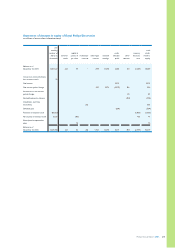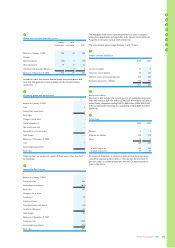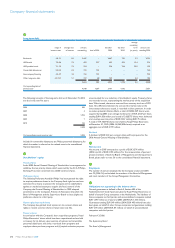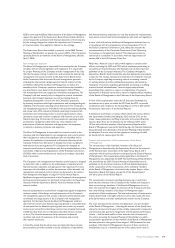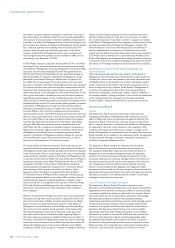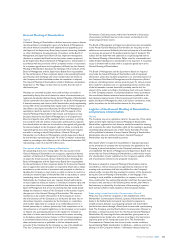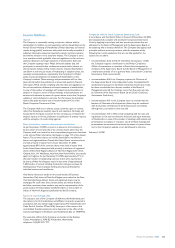Philips 2005 Annual Report Download - page 218
Download and view the complete annual report
Please find page 218 of the 2005 Philips annual report below. You can navigate through the pages in the report by either clicking on the pages listed below, or by using the keyword search tool below to find specific information within the annual report.Philips Annual Report 2005218
Corporate governance of the Philips Group
General
Koninklijke Philips Electronics N.V., a company organized under Dutch
law (the ‘Company’), is the parent company of the Philips Group (‘Philips’
or the ‘Group’). The Company, which started as a limited partnership
with the name Philips & Co in 1891, was converted into the company
with limited liability N.V. Philips’ Gloeilampenfabrieken on September 11,
1912. On May 6, 1994 the name was changed to Philips Electronics N.V.,
and on April 1, 1998 the name was changed to Koninklijke Philips
Electronics N.V. Its shares have been listed on the Amsterdam Stock
Exchange Euronext Amsterdam since 1913. The shares have been traded
in the United States since 1962 and have been listed on the New York
Stock Exchange since 1987.
Over the last decades the Company has pursued a consistent policy
to enhance and improve its corporate governance in line with US,
Dutch and international (codes of) best practices. The Company has
incorporated a fair disclosure practice in its investor relations policy,
has strengthened the accountability of its executive management and
its independent supervisory directors, and has increased the rights
and powers of shareholders and the communication with investors.
The Company is required to comply with, inter alia, Dutch Corporate
Governance rules, the US Sarbanes-Oxley Act, New York Stock Exchange
rules and related regulations, insofar as applicable to the Company.
AsummaryofsignicantdifferencesbetweentheCompany’scorporate
governance structure and the New York Stock Exchange corporate
governance standards is published on the Company’s website
(www.philips.com/investor).
In this report, the Company addresses its overall corporate governance
structure and states to what extent it applies the provisions of the
Dutch Corporate Governance Code of December 9, 2003 (the ‘Dutch
Corporate Governance Code’). The Supervisory Board and the Board
of Management, which are responsible for the corporate governance
structure of the Company, are of the opinion that the vast majority of
the principles and best practice provisions of the Dutch Corporate
Governance Code that are addressed to the Board of Management and
the Supervisory Board, interpreted and implemented in line with the
best practices followed by the Company, are being applied. Some
recommendations are not (fully) applied, and the reasons for these
deviations are set out hereinafter. Deviations from aspects of the
corporate governance structure of the Company that are described in
this report, when deemed necessary in the interests of the Company,
will be disclosed in the Annual Report. Substantial changes in the
Company’s corporate governance structure – including substantial
amendments to the Rules of Procedure of the Supervisory Board
and the Board of Management respectively – and in the Company’s
compliance with the Dutch Corporate Governance Code shall be
submitted to the General Meeting of Shareholders for discussion
under a separate agenda item.
Also in connection with the implementation of the Dutch Corporate
Governance Code and new Dutch legislation, the 2005 Annual General
Meeting of Shareholders resolved to amend the articles of association
of the Company. Pursuant to the amendment of the articles of association,
the Company’s priority shares have been withdrawn and the thresholds
for overruling the binding recommendation for appointments of members
of the Board of Management and the Supervisory Board have been
changed. Furthermore the articles of association now also contain
detailedprovisionsondealingwithconictsofinterestsofmembers
of the Board of Management and stipulate that resolutions that are so
far-reachingthattheywouldsignicantlychangetheidentityornature
of the Company or the enterprise shall be subject to the approval of
the General Meeting of Shareholders.
Board of Management
General
The executive management of Philips is entrusted to its Board of
Management under the chairmanship of the President/Chief Executive
Ofcer(CEO)andconsistsofatleastthreemembers(currentlyfour).
The members of the Board of Management have collective powers and
responsibilities. They share responsibility for the management of the
Company, the deployment of its strategy and policies, and the achievement
of its objectives and results. The Board of Management has, for practical
purposes, adopted a division of responsibilities indicating the functional
and business areas monitored and reviewed by the individual members.
According to the Company’s corporate objectives and Dutch law, the
Board of Management is guided by the interests of the Company and
itsafliatedenterpriseswithintheGroup,takingintoconsideration
the interests of the Company’s stakeholders, and is accountable for
the performance of its assignment to the Supervisory Board and the
General Meeting of Shareholders. The Board of Management follows
its own Rules of Procedure, which set forth procedures for meetings,
resolutions, minutes and (vice) chairmanship. These Rules of Procedure
are published on the Company’s website.
(Termof)Appointment,individualdataandconictsofinterests
Members of the Board of Management and the President/CEO are elected
by the General Meeting of Shareholders upon a binding recommendation
drawn up by the Supervisory Board after consultation with the
President/CEO. This binding recommendation may be overruled by
a resolution of the General Meeting of Shareholders adopted by a
simple majority of the votes cast and representing at least one-third
of the issued share capital. If a simple majority of the votes cast is in
favor of the resolution to overrule the binding recommendation, but
such majority does not represent at least one-third of the issued share
capital, a new meeting may be convened at which the resolution may
be passed by a simple majority of the votes cast, regardless of the
portion of the issued share capital represented by such majority.
Members of the Board of Management and the President/CEO are
appointed for a maximum term of four years, it being understood that
this maximum term expires at the end of the General Meeting of
Shareholders to be held in the fourth year after the year of their
appointment. Reappointment is possible for consecutive maximum
terms of four years or, if applicable, until a later retirement date or
other contractual termination date in the fourth year, unless the
General Meeting of Shareholders resolves otherwise. Members may
be suspended by the Supervisory Board and the General Meeting
of Shareholders and dismissed by the latter.
Individual data on the members of the Board of Management are
published in the chapter Our leadership that begins on page 52 of this
Annual Report, and updated on the Company’s website. The acceptance
by a member of the Board of Management of membership of the
supervisory board of another company requires the approval of the
SupervisoryBoard.TheSupervisoryBoardisrequiredtobenotied
of other important positions (to be) held by a member of the Board of
Management. No member of the Board of Management holds more
than two supervisory board memberships of listed companies, or is
a chairman of such supervisory board, other than of a Group company.
This principle was deviated from in respect of Mr Hommen, the
previousChiefFinancialOfcer(CFO),duringthelastmonthsprior
to his retirement becoming effective.
TheCompanyhasformalizeditsrulestoavoidconictsofinterests
between the Company and members of the Board of Management.
The articles of association state that in the event of a legal act or a
lawsuit between the Company and a member of the Board of Management,
certain of such member’s relatives, or certain (legal) entities in which
a member of the Board of Management has an interest, and insofar as
thelegalactisofmaterialsignicancetotheCompanyand/ortothe
respective member of the Board of Management, the respective member
of the Board of Management shall not take part in the decision-making
in respect of the lawsuit or the legal act. Resolutions concerning such
legal acts or lawsuits require the approval of the Supervisory Board.
Legal acts as referred to above shall be mentioned in the Annual Report
forthenancialyearinquestion.TheRulesofProcedureoftheBoard
of Management establish further rules on the reporting of (potential)
conictsofinterests.No(potential)conictsofinterestshavebeen
reportedduringthenancialyear2005.
Relationship between Board of Management and Supervisory Board
The Board of Management is supervised by the Supervisory Board and
provides the latter with all information the Supervisory Board needs to
Corporate governance







